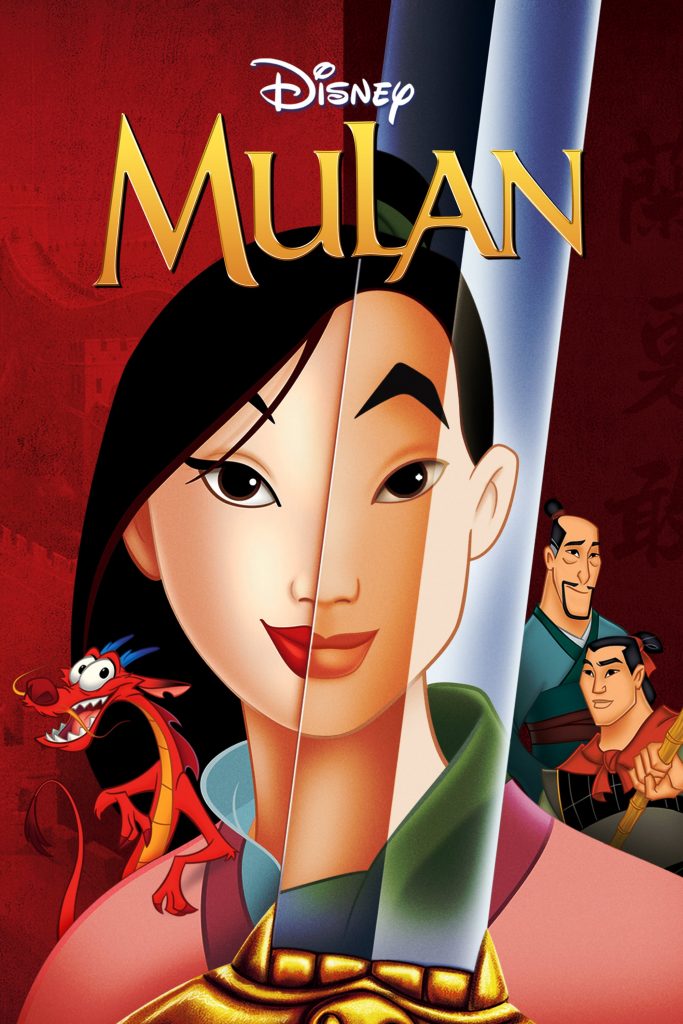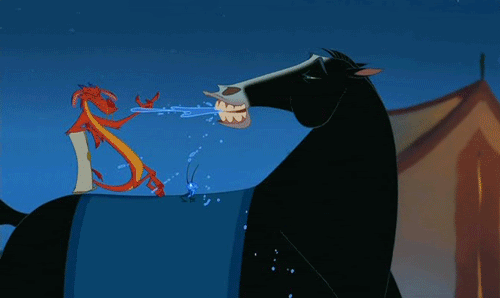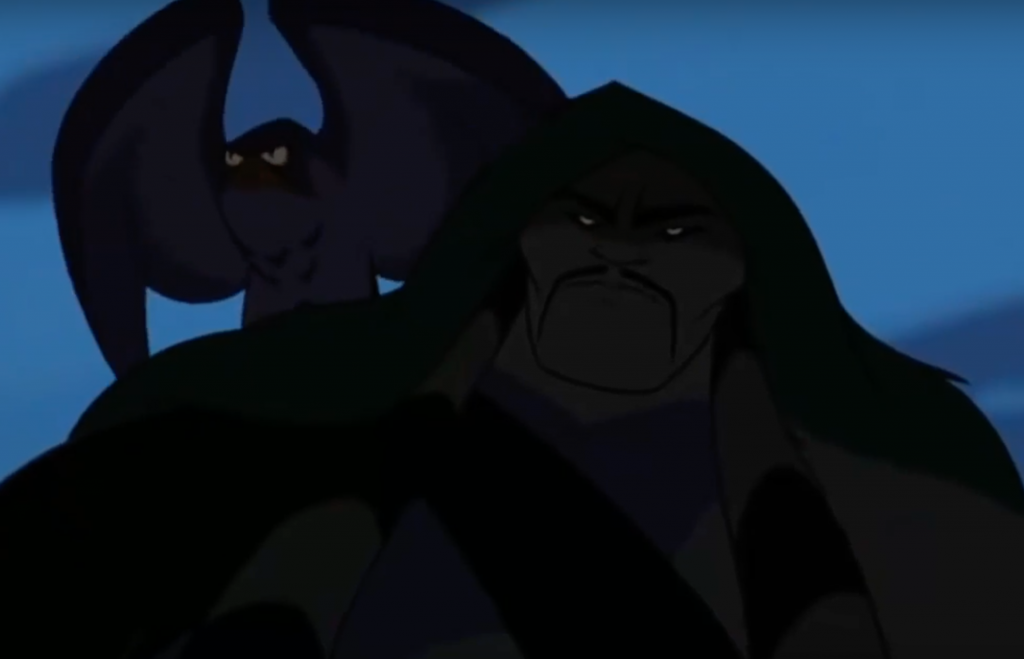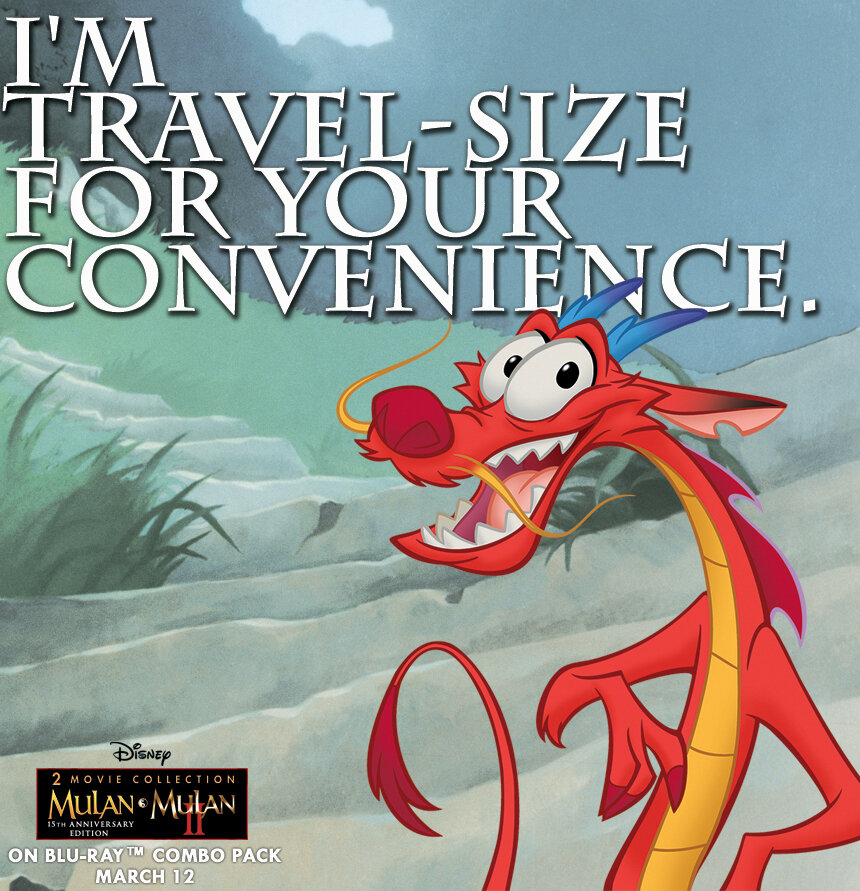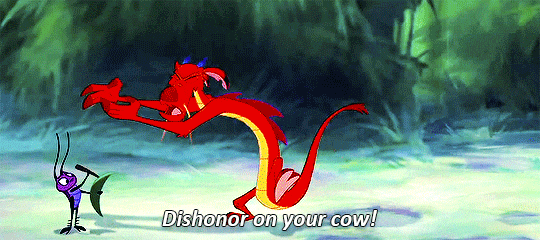Disney’s Mulan (1998) takes on a Chinese folktale of a woman who takes the place of her father in the fight against the Huns who have recently invaded China. The film follows the adventures and troubles of Mulan, a young woman who breaks the stereotypes of Disney’s classic princess, as well as the expectations which her culture places upon her. Crucially, as Mulan goes to war in the place of her father, she is assisted by three companions, Kahn her family horse, Mushu the dragon, a disgraced ancestor and a not-so-lucky cricket. The animals not only provide hilarity and comedy, but teach the viewer about the importance of friendship and identity. Also essential to the progression of the plot is Hayabusa the Falcon, who belongs to the leader of the Huns. It is he who foreshadows the invasion of China, as well as the other events of destruction throughout the film.
The film epitomises the classic Disney film, which has become a genre in itself, providing a mixture of humour, allegorical tales and happy endings. Mulan is also a musical, featuring sing-along-songs which aid comprehension of character’s emotions and messages taught. Although aimed at Children, Mulan allows viewers of all ages to identify with it’s allegorical messages, such as the power of friendship, and importance of being true to who you are. Kahn, the Fa family’s horse provides an excellent example of a wise and caring friend, who is not concerned with his own agenda. This allows readers to evaluate their own friendships against him stressing their importance. In the same way, Mushu’s character warns the viewers of the consequences of pretending to be someone who you are not. In these ways, Mulan fulfills the purpose of the children’s Disney film, to entertain and teach life skills in a fun and relevant way.
The historical heritage and culture which the film represents, set it apart from other Disney films. The film cleverly and delicately teaches the viewer of ancient cultural traditions and their importance. This is mainly done through Mushu, who is sent by the ancestors to protect Mulan.
Throughout the film, it is the animals who illustrate the film’s allegorical messages. This is despite the fact that only Mushu can communicate through speech, meaning that the audience rely on the cleverly incorporated actions and appearance of the animals to aid their understanding of the story.
The unsung hero of the film is Kahn the horse, who’s mannerisms, body language and frequent snorts of disgust reveal him to be wise, cautious and quick thinking in the face of challenges. As well as this, Kahn is portrayed as a consistent companion to Mulan throughout her troubles. One scene in which his loyalty is demonstrated is when Mulan returns home from the disastrous encounter with the matchmaker. This scene invaluable in teaching children and adults alike of the importance of high quality friendships.
The mies-en-scene shows Mulan opening the gate to the compound and poking her head through, checking that the coast is clear. Kahn follows, imitating her by also poking his head in and glancing around before entering. The imitation and likeness of mannerisms between the animal and his master is the film’s first indication of their closeness. Despite being unable to communicate through speech, the sadness of his body language suggests he is not disappointed with Mulan, nor angry at her inability to act as society expects her. Instead, he shares her pain and sorrow with her, as a close friend would do, reiterating the quality of his friendship to Mulan, but also conveys wider messages about the companionship which animals provide. The sorrow of both Mulan and Kahn is further indicated by the dull colours which are used in the scene. There is even a contrast in the shade of the sky between the glimpse which viewers get of the sky outside of the compound as the gate opens, and that inside.
There is one exception to the use of muted colours however. The reaction shot is noticeably brighter, as Mulan’s father walking out of the house to greet his daughter, his face full of expectancy. Upon reading her shame however, his expression drops. The camera angle reverts to a wide shot of the whole compound, dull in colour pallet, demonstrating his disappointment. These details remind the audience that unlike humans, the horse is not capable of disappointment or anger. Only love and affection, fear and pain.
In addition to this, upon seeing her father’s face, Mulan uses Kahn’s head to shield her own face, continuing to walk on. Kahn’s love and affection for Mulan, regardless of her behaviour provide protection and reassurance. The presence of Kahn in this scene provides a contrast to the reaction of her family, as well as recreating the child-like affection which many humans lose the ability to hold by the time they reach adulthood.
Also essential to the plot is Hayabusa is the Falcon who belongs to Shan Yu, the leader of the Huns. Throughout the film, he foreshadows devastation and destruction. As the film ultimately is one aimed at children, he is assigned to the role of baddie, the animal equivalent of his master.
In the film’s opening scene, the shot pans down to reveal the iconic Great Wall of China. The viewer sees as very suddenly, without any sound to predict, a calm patrol is disrupted as the bird swoops down into the shot, snatching the guard’s helmet. The viewer watches as the shot pans out again to reveal the bird landing on a flagpole. This is the first instance of his foreshadowing the destruction which will follow. The fact that he deliberately lands on the flag suggests not only that danger is coming, but that China as a nation, represented in the flag will be targeted. The lack of dramatic music or sound of the bird coming closer makes this much more dramatic, heightening the sense of danger as there was no warning to the bird and the subsequent destruction’s arrival.
As the shot shows only the bird perched on the flagpole, behind him the moon obscures the landscape, with dark contrasting clouds across it. This image which is created is dark, inviting the audience, particularly younger viewers to feel fear. There is no music, only a faint sound of the wind and the bird. This heightens the anticipation, until the bird calls again, a signal to the Huns. Hayabusa circles and lands on Shan Yu’s shoulder after he has scaled the wall, asserting his allegiance to his master. However, before the scene has finished he flies away into the distance. This creates the implication that it is he who is in control. By flying ahead of the humans, he is continuing with his mission to lead and direct the Huns. The audience can infer that it is not Shan Yu who is the brains behind the operation, but Hayabusa. From this beginning scene onwards, he foreshadows devastation.
It cannot be overlooked that Hayabusa is revealed in the very first scene, before any human enemies, as well as the fact that it is he who signals the start of the attack. The Falcon possesses skills which are unattainable to humans, awarding him power over them, contributing to the notion that it is the animals who move the plot forward.
Contrastingly, Mushu’s ability to speak blurs the of boundaries between animal and human. One way this is demonstrated is through his obsession with regaining influence and proving himself within the group of family ancestors, portraying him as an insecure and unreliable friend.
In the scene where he first meets Mulan the extent of his insecurities are revealed. His entrance into the scene is certainly dramatic, with the shot showing only Mushu’s shadow against a red background with flames and smoke. Crucially, the viewer sees what Mulan sees, his shadow which makes him appear must bigger than he actually is. Once his true size revealed, he is no longer the only character in the shot for the rest of the scene, with the only exception when he is being trampled on by Kahn. Until this point the colours used are earthy tones of greens and browns, which contrast against the red and orange which accompany Mushu, adding to the illusion of his great size and importance which he attempts to create.
Interestingly, without the illusion of size and greatness which Mushu desires, he uses other tactics to compensate for this. Mushu refers to Kahn multiple times as a “cow”, “If I was my real size, your cow would die of fright”. This is significant for a number of reasons, firstly it is ironic that an animal is deliberately insulting a fellow animal through assigning him a derogatory status, something which humans do, likening Mushu to a human and creating a division between him and the animals in the film. Moreover, this reaffirms the notion that in his quest to achieve greatness he is threatened by the horse not only because of his relationship with Mulan, but also his size. After Mulan comments on is size, he responds, “I’m travel size for your convenience”. Unlike Mulan, viewers are aware that this is his true size/identity. His response is an attempt to make himself appear more intentional and powerful, hiding his insecurities with humour. The deceit which Mushu employs in order to appear as someone who he is not, maintains his position between animal and human. This perhaps is the root of his insecurities, creating powerful message and warning of the consequences of being unable to accept yourself and striving to be someone else. He also presents a warning against putting trust in a friend who is concerned only with their own agenda.
It is the presence of animals within Mulan which drives forward the plot, arguably possessing more influence than humans. This is demonstrated through Hayabusa who repeatedly foreshadows devastation. It is also the animals who teach viewers valuable life lessons. The contrasting personalities of Kahn and Mushu comically and cleverly highlight issues of friendship and identity.
Mushu spends the majority of the film attempting to create an identity which is not true to him. Although not done with malicious intent, his insecurities and ambition create a deceitful character who hinders the efforts of Mulan. One scene in which this is demonstrated is just before the group’s first encounter with the Huns. Whilst hiding in the cart which holds the army’s weapons, Mushu’s attempts to impress the cricket with his fire-breathing accidentally sets off one of the cannons, alerting the enemy to their location. Mulan is blamed, and a series of action-sequences and deaths follow. Although dramatic in order to maintain entertainment value, this exposes the audience to the severe consequences of striving to become someone who you are not. Moreover, it was not just Mushu and Mulan who were put in danger, but the whole group of soldiers, showing how others, and in this case, the whole country can be affected by the smallest of actions.
Kahn however, provides an excellent example to the audience of unconditional love. His companionship to Mulan is consistent throughout the film. As well as the scene where Mulan returns from the matchmaker, there are many more instances where his loyalty is demonstrated. Not only does this provide an excellent example, but contrasted against Mushu heightens the sense of importance which is placed upon the value of good friends.
The director’s attempt to keep the film loyal to the heritage and culture which inspired it, allow audiences of all ages to fully engage with the messages conveyed. Although the genre of the film allows for fantasy with little or any contest from the viewer, Mushu’s persona and ability to speak, decreases his authenticity, and therefore reliability. The combination of Kahn and Hayabusa’s likeness to reality (as much as a Disney animation allows for) and the comedy of Mushu works together to create allow the viewer to align their own friendships with the example provided in Kahn.
This precision with which the film has been produced allows it to challenge and raise awareness of some very relevant and key issues in society, such as identity and friendships. Mulan provides a light and fun resource which translates relevant issues into songs and characters which can be adopted and remembered by children who are beginning their journey of navigating life.
Bibliography
Mulan. Dir. Tony Bancroft and Barry Cook. Buena Vista Pictures, 1998
Further Reading
Ming-Na Wen on Being the Voice of Mulan https://www.youtube.com/watch?v=3rVvaubjlRo [Accessed 19 May 2018]
Ng, J. (2017) Warrior and Weaver: The Many Legends of Mulan Medium https://medium.com/@nettlefish/warrior-and-weaver-the-many-legends-of-mulan-730ffa925b89 [Accessed 20 May 2018]
Noyer, J. (2008) Tony Bancroft balances the yin and the yang in directing Mulan Animated Views http://animatedviews.com/2008/tony-bancroft-balances-the-yin-and-the-yang-in-directing-mulan/ [Accessed 20 May 2018]
Wells, P. (2009) The Animated Bestiary: Animals, Cartoons, and Culture. London: Rutgers University Press.
Edwards, L. (2016) Women Warriors and Wartime Spies of China. Cambridge: Cambridge University Press
Filmsite. Animated Films Part 1 https://www.filmsite.org/animatedfilms.html [Accessed 20 May 2018]
